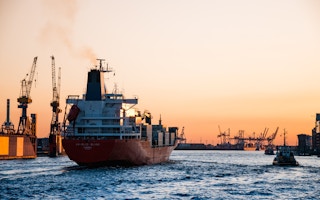Hopes have been pinned on liquefied natural gas (LNG) as a climate solution for the maritime industry, but switching vessels to the fuel would only serve to worsen shipping’s climate impact due to previously underestimated leakage of the climate super-pollutant methane, new research released this week has revealed.
To continue reading, subscribe to Eco‑Business.
There's something for everyone. We offer a range of subscription plans.
- Access our stories and receive our Insights Weekly newsletter with the free EB Member plan.
- Unlock unlimited access to our content and archive with EB Circle.
- Publish your content with EB Premium.
The study, by the International Council on Clean Transportation (ICCT), shows that much more methane, which is the major constituent of natural gas, than formerly thought escapes along the process of extracting the gas from the earth and burning it in an engine, bringing up total climate emissions from LNG to an amount 70-82 per cent greater than that from other marine fuels.
Further exacerbating LNG’s climate effects is the fact that methane is a highly potent greenhouse gas. Over a 20-year period, it is capable of trapping 86 times more heat than carbon dioxide, and 36 times more over a 100-year period.
If upstream emissions and methane slips from engines are factored in, there are no climate benefits from running vessels on natural gas, regardless of the engine technology used. Continued misdirected investment in LNG infrastructure on ships and on shore could make it harder to transition to low-carbon and zero-carbon fuels in the future, reads the report, titled ‘The climate implications of using LNG as a marine fuel’.
“
If we were to transition to LNG as the primary marine fuel, the overall climate emissions and impact from shipping would greatly increase.
Bryan Comer, senior researcher, International Council on Clean Transportation Marine Program
Interest in LNG ships, however, is on the rise. That climate concerns, in addition to stricter air pollution standards and energy efficiency regulations, are driving this surge in interest is because the decarbonisation target laid down by the United Nations’ International Maritime Organisation (IMO) two years ago, challenging the sector to halve its carbon dioxide emissions by 2050, is too narrow.
It has neglected methane emissions, leading the industry astray in its search for ways to address its climate impacts.
This is a grave mistake, said Bryan Comer, senior researcher at the International Council on Clean Transportation (ICCT) Marine Program in Washington DC, and one of the authors of the study.
“Methane that slips from marine engines unburned or leaks from upstream production of liquefied natural gas is driving the worst global warming impacts compared to conventional fuels, which emit carbon dioxide instead,” he told Eco-Business.
“If we were to transition to LNG as the primary marine fuel, the overall climate emissions and impact from shipping would greatly increase,” he said.
International shipping at present contributes 3 per cent of global man-made greenhouse gas emissions. On its current trajectory, this share could grow to 17 per cent, but if ship operators continue to uptake LNG, climate emissions could rise beyond that.
Kendra Ulrich, senior shipping campaigner at Vancouver-based environmental non-profit Stand.earth, said: “For a sector that is already one of the largest contributors of global greenhouse gas emissions, this report reveals that switching ships to LNG is worse than doing nothing.”
“This should serve as an alarming wake-up call for the International Maritime Organization, which must act now to ensure it includes all greenhouse gas emissions in its emissions reduction strategy,” she said.
The study says if the industry controlled upstream methane emissions and used high-pressure dual-fuel engine technology with reduced methane slip, natural gas could shrink shipping’s climate impact.
But LNG’s production is shifting to shale gas, where containing leakage is difficult, and only 90 out of more than 750 LNG-fuelled vessels that currently sail the world’s seas use high-pressure systems, making reductions in climate emissions difficult.
The most popular LNG engine technology—low-pressure dual-fuel four-stroke engines, which is used on at least 300 ships—emits 70 per cent more life-cycle greenhouse gas emissions when burning LNG instead of marine gas oil, and 82 per cent more than using marine gas oil in a comparable medium-speed diesel engine, reads the report.
Tackling climate change on paper, not in reality
Because burning LNG emits less carbon dioxide compared to conventional fuels, natural gas has been hailed as a transition fuel that could help the sector meet its emissions target.
LNG’s low sulphur content and available technologies to slash nitrogen oxide emissions have further boosted its popularity, as they enable shipowners to comply with the IMO’s new global sulphur cap and operate in areas with stringent air quality standards.
“LNG is attractive because it checks all the boxes on the regulatory compliance side,” said Comer.
“
If we fail to include all greenhouse gas emissions and focus only on carbon dioxide, we might end up with a large number of ships fulfilling all efficiency requirements, but where the greenhouse gas savings are on paper only.
Dr Elizabeth Lindstad, chief scientist, maritime transport, SINTEF Ocean
That low-pressure injection systems are the most common LNG engines in operation indicates how narrow regulations have misguided the sector’s decarbonisation efforts: these engines are designed to cut nitrogen oxide emissions—a regulated pollutant—but show high risk of methane slip, which is not included in pollution standards.
“What we are missing is the regulatory driver that can shift the sector towards lower emissions and eventually to zero emissions,” Comer told Eco-Business.
Dr Elizabeth Lindstad, chief scientist, maritime transport, at Norwegian research organisation SINTEF Ocean, said there was a need for adopting policies that could reduce the broader greenhouse gas emissions of shipping instead of carbon dioxide only.
“If we fail to include all greenhouse gas emissions and focus only on carbon dioxide, we might end up with a large number of ships fulfilling all efficiency requirements, but where the greenhouse gas savings are on paper only,” she said.








